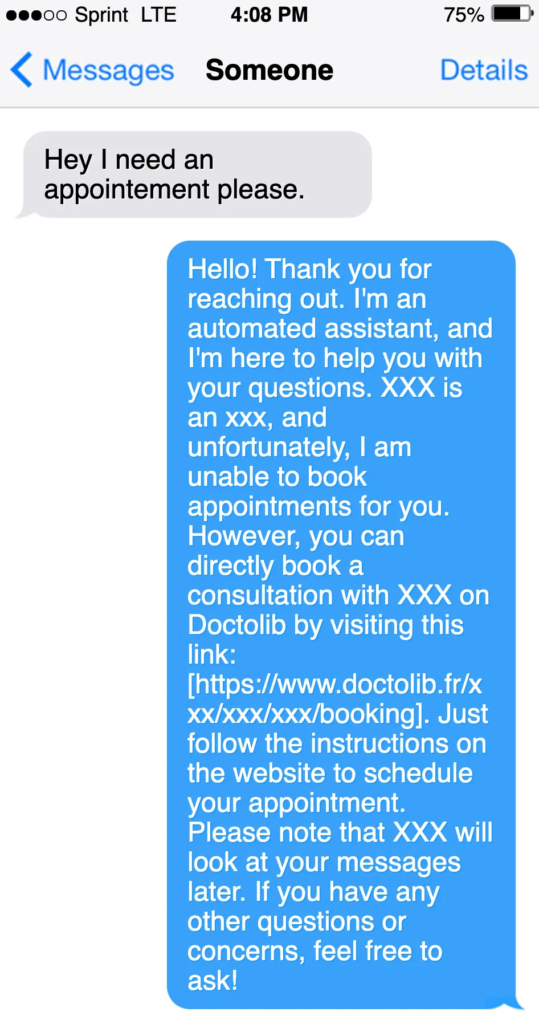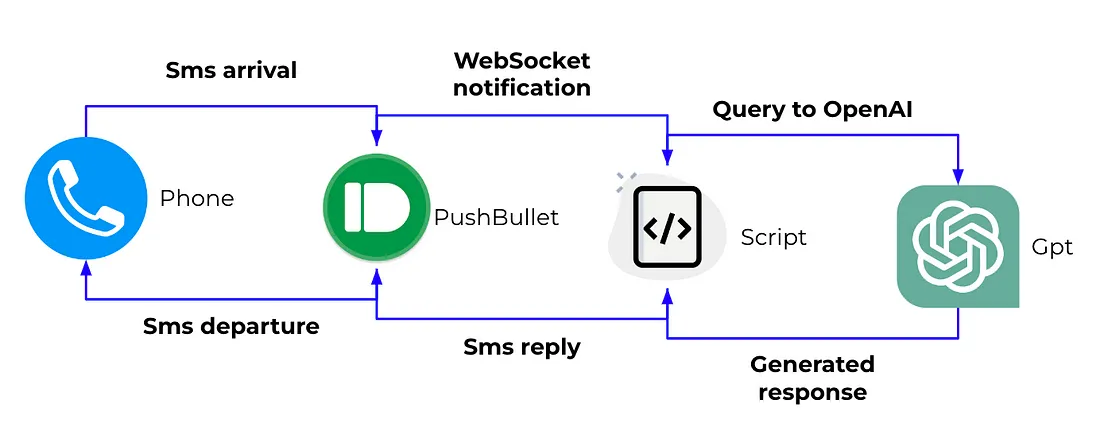Introduction
In the backdrop of the overwhelming influx of messages we received, I decided to automate the process of replying to these messages. The solution? A combination of Pushbullet’s API for SMS management and OpenAI’s GPT-3 for generating human-like responses.
Overall Architecture
- Pushbullet: This service allows users to see phone notifications on their computer. It provides an API to manage SMS, which we use to listen for incoming messages and send replies.
- OpenAI’s GPT-3: Once we receive a message, we use GPT-3 to generate a human-like response based on the content of the incoming SMS.
Code Breakdown
Setting Up
import os
import json
import openai
import logging
import asyncio
import requests
import websockets
We start by importing the necessary libraries. The key ones here are openai for interacting with GPT-3, requests for HTTP requests, and websockets for real-time communication with Pushbullet.
Configuration
openai.api_key = os.environ.get('OPENAI_API_KEY')
access_token = os.environ.get('PUSHBULLET_ACCESS_TOKEN')
device_iden = os.environ.get('DEVICE_ID')
Sensitive information like API keys are fetched from environment variables for security reasons.
Listening for SMS
async def listen_for_sms():
while True:
try:
async with websockets.connect(f'wss://stream.pushbullet.com/websocket/{access_token}') as websocket:
while True:
response = await websocket.recv()
message_data = json.loads(response)
if message_data.get('type') == 'push' and message_data.get('push', {}).get('type') == 'sms_changed':
notifications = message_data.get('push', {}).get('notifications', [])
for notification in notifications:
thread_id = notification.get('thread_id')
sender_name = notification.get('title')
sms_text = notification.get('body')
print(f'New SMS from {sender_name}: {sms_text}')
threads_url = f'https://api.pushbullet.com/v2/permanents/{device_iden}_threads'
threads_response = requests.get(threads_url, headers=headers)
if threads_response.status_code == 200:
threads_data = threads_response.json()
threads = threads_data.get('threads', [])
for thread in threads:
if thread.get('id') == thread_id:
recipients = thread.get('recipients', [])
if recipients:
phone_number = recipients[0].get('address')
if phone_number:
await send_reply(phone_number, sms_text)
else:
logging.error(f'No phone number found for thread_id {thread_id}')
else:
logging.error(f'No recipients found for thread_id {thread_id}')
break
else:
logging.error(f'Failed to get thread data: {threads_response.text}')
except websockets.ConnectionClosedError as e:
logging.error(f"Connection closed: {e}, retrying in 1 seconds...")
await asyncio.sleep(1)
except Exception as e:
logging.error(f"An unexpected error occurred: {e}")
This asynchronous function constantly listens for incoming SMS using Pushbullet’s WebSocket API. When a new SMS arrives, it fetches the thread details to get the sender’s phone number and then triggers a reply using GPT-3.
Generating and Sending Replies
async def send_reply(phone_number, sender_message):
try:
gpt_response = openai.ChatCompletion.create(
model="gpt-3.5-turbo",
messages=[
{
"role": "system",
"content": (
"You are a helpful assistant for xxx, an xxx. "
"Your task is to inform patients that xxx will look at their messages later "
"and they can book a consultation directly on Doctolib at "
"https://www.doctolib.fr/xxx/xxx/xxx/booking."
)
},
{"role": "user", "content": sender_message}
]
)
gpt_message = gpt_response['choices'][0]['message']['content']
print(f'Sending response to {phone_number}: {gpt_message}')
data = {
'data': {
'target_device_iden': device_iden,
'addresses': [phone_number],
'message': gpt_message
}
}
response = requests.post('https://api.pushbullet.com/v2/texts', headers=headers, data=json.dumps(data))
response.raise_for_status()
logging.info('Reply sent successfully.')
except Exception as e:
logging.error(f'Failed to send reply: {e}')
This function takes in the sender’s phone number and their message. It then communicates with OpenAI’s GPT-3 to generate a suitable reply. The context provided to GPT-3 is that of an assistant, guiding patients to book consultations online.
Once the reply is generated, it’s sent back to the sender using Pushbullet’s API.
Result

Sources:
